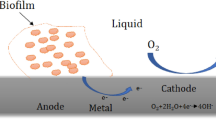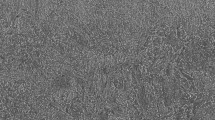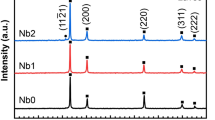Abstract
Epoxy resin coating often exhibits good anticorrosive properties. The present study evaluates the corrosion of aluminum coupons using bacterial and fungal isolates and the synthesis of aluminum nanoparticles using sol–gel method for anticorrosion assay of coupons. Isolates were collected from the sewage area, VIT, Vellore, Tamil Nadu, India. Surface or topological analyses were performed using SEM and AFM analytical methods. The weight loss results revealed that a higher corrosion rate was observed in bacterial treated (0.032 ± 0.1 mm/y) compared with that of fungal-treated (0.026 ± 0.01 mm/y) at the end of the exposure period of 336 h. This is because microbial colonies boost corrosion rates locally by establishing a corrosive environment. Corrosion rate of bacterial treated aluminum coupon was found to be 0.051 mm/year, and fungal-treated metal was found to be 0.041 mm/year. Nanoparticles synthesized showed good anticorrosion property due to their larger surface area and growth inhibition property. Scanning electron microscopic images of epoxy nanoparticle coated workpiece exhibited no pitting showing good anticorrosive nature.






Similar content being viewed by others
References
C.J. McNamara, T.D. Perry IV., R. Leard, K. Bearce, J. Dante, and R. Mitchell, Corrosion of Aluminum Alloy 2024 by Microorganisms Isolated from Aircraft Fuel Tanks, Biofouling, 2005, 21(5–6), p 257–265.
V.F. Smirnov, D.V. Belov, T.N. Sokolova, O.V. Kuzina, and V.R. Kartashov, Microbiological Corrosion of Aluminum Alloys, Appl. Biochem. Microbiol., 2008, 44(2), p 192–196. https://doi.org/10.1134/S0003683808020117
X. Dai, H. Wang, L.-K. Ju, G. Cheng, H. Cong, and B.Z. Newby, Corrosion of Aluminum Alloy 2024 Caused by Aspergillus Niger, Int. Biodeterior Biodegrad., 2016, 115, p 1–10.
J. Wang, F. Xiong, H. Liu, T. Zhang, Y. Li, C. Li, W. Xia, H. Wang, and H. Liu, Study of the Corrosion Behavior of Aspergillus Niger on 7075–T6 Aluminum Alloy in a High Salinity Environment, Bioelectrochemistry, 2019, 129, p 10–17.
A. Rajasekar and Y.-P. Ting, Microbial Corrosion of Aluminum 2024 Aeronautical Alloy by Hydrocarbon Degrading Bacteria Bacillus Cereus ACE4 and Serratia Marcescens ACE2, Ind. Eng. Chem. Res., 2010, 49(13), p 6054–6061.
A. Rajasekar and Y.-P. Ting, Microbial Corrosion of Aluminum 2024 Aeronautical Alloy by Hydrocarbon Degrading Bacteria Bacillus Cereus ACE4 and Serratia Marcescens ACE2, Ind. Eng. Chem. Res., 2010, 49(13), p 6054–6061. https://doi.org/10.1021/ie100078u
U. Jirón-Lazos, F. Corvo, S.C. de la Rosa, E.M. García-Ochoa, D.M. Bastidas, and J.M. Bastidas, Localized Corrosion of Aluminum Alloy 6061 in the Presence of Aspergillus Niger, Int. Biodeterior Biodegrad., 2018, 133, p 17–25.
S. Geetha, S. Lakshmi, and K. Bharathi, Solanum Trilobatum as a Green Inhibitor for Aluminium Corrosion in Alkaline Medium, J. Chem. Pharm. Res., 2013, 5(5), p 195–204.
T. Zhang, J. Wang, G. Zhang, and H. Liu, The Corrosion Promoting Mechanism of Aspergillus Niger on 5083 Aluminum Alloy and Inhibition Performance of Miconazole Nitrate, Corros. Sci., 2020, 176, p 108930.
G. Płaza and V. Achal, Biosurfactants: Eco-Friendly and Innovative Biocides against Biocorrosion, Int. J. Mol. Sci., 2020, 21(6), p 2152.
N. Rcheulishvili, Y. Zhang, D. Papukashvili, and Y.-L. Deng, Survey and Evaluation of Spacecraft-Associated Aluminum-Degrading Microbes and Their Rapid Identification Methods, Astrobiology, 2020, 20(8), p 925–934.
J.S. de Andrade, M.R.S. Vieira, S.H. Oliveira, S.K. de Melo Santos, and S.L. Urtiga Filho, Study of Microbiologically Induced Corrosion of 5052 Aluminum Alloy by Sulfate-Reducing Bacteria in Seawater, Mater. Chem. Phys., 2020, 241, p 122296.
S. Kokilaramani, M.M. Al-Ansari, A. Rajasekar, F.S. Al-Khattaf, A. Hussain, and M. Govarthanan, Microbial Influenced Corrosion of Processing Industry by Re-Circulating Waste Water and Its Control Measures-A Review, Chemosphere, 2021, 265, p 129075.
Y. Nie, J. Huang, S. Ma, Z. Li, Y. Shi, X. Yang, X. Fang, J. Zeng, P. Bi, and J. Qi, MXene-Hybridized Silane Films for Metal Anticorrosion and Antibacterial Applications, Appl. Surf. Sci., 2020, 527, p 146915.
C. Vargel, Corrosion of Aluminium, Elsevier, Amsterdam, 2020.
B.W. Stamps, C.L. Bojanowski, C.A. Drake, H.S. Nunn, P.F. Lloyd, J.G. Floyd, K.A. Emmerich, A.R. Neal, W.J. Crookes-Goodson, and B.S. Stevenson, In Situ Linkage of Fungal and Bacterial Proliferation to Microbiologically Influenced Corrosion in B20 Biodiesel Storage Tanks, Front. Microbiol., 2020, 11, p 167.
Y. Gao, D. Feng, M. Moradi, C. Yang, Y. Jin, D. Liu, D. Xu, X. Chen, and F. Wang, Inhibiting Corrosion of Aluminum Alloy 5083 through Vibrio Species Biofilm, Corros. Sci., 2021, 180, p 109188.
B. Brycki and A. Szulc, Gemini Surfactants as Corrosion Inhibitors. A Review, J. Mol. Liq., 2021, 344, p 117686.
S.D. Kumar, M. Ravichandran, A. Jeevika, B. Stalin, C. Kailasanathan, and A. Karthick, Effect of ZrB2 on Microstructural, Mechanical and Corrosion Behaviour of Aluminium (AA7178) Alloy Matrix Composite Prepared by the Stir Casting Route, Ceram. Int., 2021, 47(9), p 12951–12962.
A.M. Younis, T.H. Rakha, M.M. El-Gamil, and G.M.A. El-Reash, Synthesis and Characterization of Some Complexes Derived from Isatin Dye Ligand and Study of Their Biological Potency and Anticorrosive Behavior on Aluminum Metal in Acidic Medium, J. Inorg. Organomet. Polym. Mater., 2021, 32, p 895–911.
P. Chakraborty and J. Abraham, Comparative Study on Degradation of Norfloxacin and Ciprofloxacin by Ganoderma Lucidum JAPC1, Korean J. Chem. Eng., 2017, 34(4), p 1122–1128.
A. Chatterjee and J. Abraham, Mycoremediation of 17 Β-Estradiol Using Trichoderma Citrinoviride Strain AJAC3 along with Enzyme Studies, Environ. Prog. Sustain. Energy, 2019, 38(4), p 13142.
A. Chatterjee, J. Abraham, and M.R. Regina, Antibiotic Profiling of Bacteria Isolated from Sewage Soil Sample, Res. J. Pharm. Technol., 2017, 10(4), p 1053–1059.
V. Shamly, A. Kali, S. Srirangaraj, and S. Umadevi, Comparison of Microscopic Morphology of Fungi Using Lactophenol Cotton Blue (LPCB), Iodine Glycerol and Congo Red Formaldehyde Staining, J. Clin. Diagn. Res., 2014, 8(7), p DL01.
A. Gajendiran and J. Abraham, Biomineralisation of Fipronil and Its Major Metabolite, Fipronil Sulfone, by Aspergillus Glaucus Strain AJAG1 with Enzymes Studies and Bioformulation, 3 Biotech, 2017, 7(3), p 212.
A. Schirp and M.P. Wolcott, Influence of Fungal Decay and Moisture Absorption on Mechanical Properties of Extruded Wood-Plastic Composites, Wood Fiber Sci., 2005, 37(4), p 643–652.
S. Mohanan, A. Rajasekar, N. Muthukumar, S. Maruthamuthu, and N. Palaniswamy, The Role of Fungi on Diesel Degradation, and Their Influence on Corrosion of API 5LX Steel, Corros. Prevent. Control, 2005, 52(4), p 123–130.
E.O. Imo and A.M. Chidiebere, Fungal Influenced Corrosion of Aluminium in the Presence of Acremonium Kiliense, Int. J. Appl. Microbiol. Biotechnol. Res., 2019, 7, p 1–6.
F. Güzelçimen, B. Tanören, Ç. Çetinkaya, M.D. Kaya, H.İ Efkere, Y. Özen, D. Bingöl, M. Sirkeci, B. Kınacı, and M.B. Ünlü, The Effect of Thickness on Surface Structure of Rf Sputtered TiO2 Thin Films by XPS, SEM/EDS, AFM and SAM, Vacuum, 2020, 182, p 109766.
M.G. Fontana and N.D. Greene, Corrosion Engineering. 1967, 1967.
P.U. Ingle, J.K. Biswas, M. Mondal, M.K. Rai, P. Senthil Kumar, and A.K. Gade, Assessment of in Vitro Antimicrobial Efficacy of Biologically Synthesized Metal Nanoparticles against Pathogenic Bacteria, Chemosphere, 2022, 291, p 132676. https://doi.org/10.1016/j.chemosphere.2021.132676
M. Farahmandjou and N. Golabiyan, Synthesis and Characterization of Alumina (Al), Int. J. Bio-Inorg. Hybr. Nanomater., 2016, 5(1), p 73–77.
Z. Sadouk-Hachaïchi, A. Tazerouti, and H. Hacene, Growth Kinetics Study of a Bacterial Consortium Producing Biosurfactants, Constructed with Six Strains Isolated from an Oily Sludge, Adv. Biosci. Biotechnol., 2014, 05(05), p 418–425. https://doi.org/10.4236/abb.2014.55050
G. Bystrzejewska-Piotrowska, J. Golimowski, and P.L. Urban, Nanoparticles: Their Potential Toxicity, Waste Environ. Manag. Waste Manag, 2009, 29(9), p 2587–2595.
J. Ghosal, A Study on Microbe-Metal Interaction: Aluminium Alloy (6061) and Bacillus Sp. in Simulated Marine Environment, 2022, https://doi.org/10.21203/rs.3.rs-1780507/v1.
A. Jamuna Bai, V. Ravishankar Rai, and V. Pradeepa, Evaluation of the Antimicrobial Activity of Three Medicinal Plants of South India, Malays. J. Microbiol., 2011, 7(1), p 14–18.
Y. Cao, C. Zou, C. Wang, H. Liang, W. Chen, and W. Li, Effect of TiO2 Nanoparticles and SDBS on Corrosion Behavior of 3003 Aluminum Alloy in Aqueous Ethylene Glycol Containing Chloride Ions at High Temperature, J. Alloys Compd., 2021, 873, p 159820. https://doi.org/10.1016/j.jallcom.2021.159820
H. Klöcker and C. Yukna, Aluminum Sheet Metal Damage Mechanisms Application to Trimming and Hemming, Aluminium Alloys - Recent Trends in Processing, Characterization, Mechanical Behavior and Applications. S. Sivasankaran Ed., InTech, London, 2017. https://doi.org/10.5772/intechopen.70687
V.V. Nelson, O.T. Maria, S.V. Mamiè, and P.C. Maritza, Microbiologically Influenced Corrosion in Aluminium Alloys 7075 and 2024, Aluminium Alloys - Recent Trends in Processing, Characterization, Mechanical Behavior and Applications. S. Sivasankaran Ed., IntechOpen, London, 2017
Y.H. Leung, A.M.C. Ng, X. Xu, Z. Shen, L.A. Gethings, M.T. Wong, C.M.N. Chan, M.Y. Guo, Y.H. Ng, and A.B. Djurišić, Mechanisms of Antibacterial Activity of MgO: Non-ROS Mediated Toxicity of MgO Nanoparticles Towards Escherichia Coli, Small, 2014, 10(6), p 1171–1183.
J. Lellouche, A. Friedman, R. Lahmi, A. Gedanken, and E. Banin, Antibiofilm Surface Functionalization of Catheters by Magnesium Fluoride Nanoparticles, Int. J. Nanomed., 2012, 7, p 1175.
Acknowledgments
The authors would like to express their gratitude to the management of VIT, Vellore.
Author information
Authors and Affiliations
Contributions
JA contributed to conceptualization and methodology, reviewing and editing, and project supervision. JA and MS performed data curation and writing—original draft preparation. AS performed writing—original draft preparation. JAK performed formal analysis, data visualization, and investigation. JPA performed supervision. OR performed reviewing, editing and project administration.
Corresponding author
Ethics declarations
Conflict of Interest
The authors have no conflict of interest to declare.
Additional information
Publisher's Note
Springer Nature remains neutral with regard to jurisdictional claims in published maps and institutional affiliations.
Supplementary Information
Below is the link to the electronic supplementary material.
Rights and permissions
Springer Nature or its licensor (e.g. a society or other partner) holds exclusive rights to this article under a publishing agreement with the author(s) or other rightsholder(s); author self-archiving of the accepted manuscript version of this article is solely governed by the terms of such publishing agreement and applicable law.
About this article
Cite this article
Abraham, J., Shetty, M., Suresh, A. et al. Anticorrosive Property of Aluminum Chloride Nanoparticles on Microbial-Induced Corrosion on Aluminum Workpiece. J. of Materi Eng and Perform 32, 9725–9734 (2023). https://doi.org/10.1007/s11665-023-07814-8
Received:
Revised:
Accepted:
Published:
Issue Date:
DOI: https://doi.org/10.1007/s11665-023-07814-8




